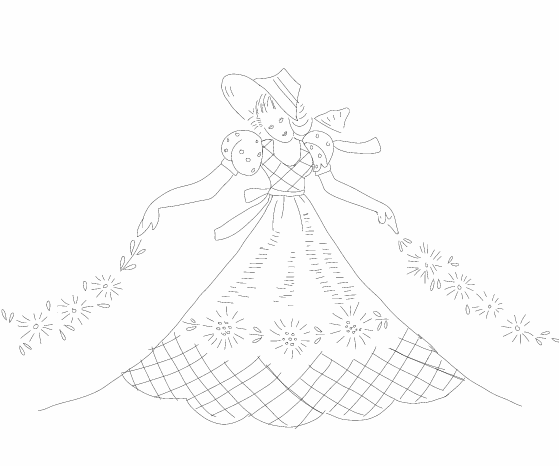Surprise, surprise! This week's free pattern isn't a tracing, it's a translation! Take a gander below for my Google assisted translation of one of the projects from the Schoeller Wolle/Esslinger Wolle pamphlets. Also pictured is a scan of the original instructions in German. Any German readers, please let me know if I got anything wrong!
Schoeller Wolle/Esslinger Wolle
Pamphlet – #2231 Cross
Knitted Bolero – Translated from original German
Size:
36/38
Bust of the Model:
about 92 cm
Total Length:
43cm
Materials:
SCHOELLER Wool “Carmen” 450g Black, ESSLINGER Wool “Gold and
Silver” 200g Black, One pair INOX Tric needles size 4.5 and 5mm,
and One INOX circular needle size 4mm 120cm long.
Use two strands of “Gold and
Silver”
Stockinette Stitch:
RS row knit, WS row purl
Stripe Sequence in St. St.: *5.5cm
(about 12 rows) in “Carmen” using 5mm needle, 6 rows in “Gold
and Silver” using 4.5mm needle* Repeat between *'s
Swatch test and change needles as
necessary!
Gauge:
14sts by 30 rows = 10cm
Work:
Using two strands of “Gold and Silver” cast on 48 sts with a 4.5
mm needle and work in K1, P1 for 2 cm. Begin stripe sequence.
Switch
to “Carmen”, increase one stitch on each end of the 4th,
6th,
and 8th
rows, after 12 rows in “Carmen” switch to “Gold and Silver”.
In the first row with “Gold and Silver” decrease 14 sts,
distributed evenly.
Continue
the stripe sequence, increasing and decreasing stitches as follows:
1st
Stripe “Carmen”: increase 10 sts,
1st
Stripe “Gold and Silver”: decrease 5 sts,
2nd
Stripe “Carmen”:
increase 10 sts,
2nd
Stripe “Gold and Silver”: decrease 5 sts,
3rd
Stripe “Carmen”: increase 14 sts,
3rd
Stripe “Gold and Silver”: decrease 9 sts,
4th
Stripe “Carmen”: inrease 17 sts
4th
Stripe “Gold and Silver”: decrease 12 sts,
5th
Stripe “Carmen”: inrease
19 sts
5th
Stripe “Gold and Silver”:
decrease 14 sts,
6th
Stripe “Carmen”: inrease
21 sts
6th
Stripe “Gold and Silver”:
decrease 19 sts,
7th
Stripe “Carmen”: inrease
24 sts
7th
Stripe “Gold and Silver”:
decrease 19 sts,
8th
Stripe “Carmen”: inrease
24 sts
8th
Stripe “Gold and Silver”:
decrease 19 sts,
Simultaneously:
In
the 2nd
through 6th
stripes in “Carmen” increase 1 on each end in the 4th,
6th,
and 8th
rows.
In
the 7th
stripe in “Carmen” increase 1 st on each end of the 4th
and 6th
rows.
After
the 8th
“Gold and Silver” stripe divide the work for the neckline and
continue to work both parts separately. (57 sts each side):
Still
using “Gold and Silver” cast off 1x2 and 1x1 sts at the center.
Increase 10 sts distributed evenly, then repeat the cast off again.
The 9th stripe in “Gold
in Silver” is the center back!
Finish
the piece in “Carmen”; for the neckline on the left side work
every other row 8x4 sts decreased. For the rounding at the right
side of the piece, on the 3rd
row in “Carmen” cast off every other row 2x1, 3x2, and 3x3 sts,
then cast off remaining 8 sts.
Work
the other half of the bolero as above, reversing neckline shaping.
Completion:
Close
seams. With circular needle and 2 strands of “Gold and Silver”
pick up 286 sts along the front, bottom, and neckline edges (lower
back edge 78sts, front pieces 172 sts each, back neckline 36 sts).
Work in K1, P1 for 2.5 cm, cast off in pattern.
My Notes:
Hoo-boy, this one is a doosy...
I am
not sure if it is because of how German knitting patterns are
written, or because this pattern was crammed onto a small pamphlet,
but it's a bit sparse. Specific stitches are not given for
increasing or decreasing, and how many stitches to add or subtract
and when is at best stated as “increase this many in this row,
distributed evenly.”
The
bold and exclamations are all straight from the pattern. They were
among the easiest things to figure out. This one was a lot tougher
to decipher than the Dutch pattern, as there were more abbreviations
and no key as to what they meant. Google and some German speaking
friends helped me out with words, but they aren't knitters, so I made
the best sense of it that I could. Perhaps if I give a try at
knitting this pattern I will write it out with a little more detail.
There is a lot going on at once in this pattern, and it's not
immediately intuitive with the scant instructions.
The
bit about the 9th
stripe of “Gold and Silver” being the center back especially
confused me, as I don't think there is a 9th
stripe. You finish each half of the bolero with “Carmen” after
the 8th
stripe, and then sew the halves together. Maybe they just mean where
the 9th
stripe would be if there was one? Also, where the neckline begins
the pattern clearly says “after the 8th
'Gold and Silver' stripe”, but then also clearly says to do the
next bit in 'Gold and Silver'. Is this stripe wider than the others
then? Or is it meant to be done before the end of the stripe?
I
wrote the pattern above as it is in the pamphlet, but I want to add
what I believe is going on in the stripe sequence just based on the
diagram given and my own knitting experience. While it seems from
the text like there are 9 of each stripe (set up plus 8 more) I think
the setup is meant to happen in the first stripe. The diagram only
shows 8 stripes. I believe the increases and decreases in each stripe
are supposed to happen in the first row of each stripe, and the other
increases and decreases (stated at the very start and under
'simultaneously') are additional to those. As I have not knit this
yet, I cannot say for sure, but that is my best guess at how to
reconcile the text and the diagram.
As
for the yarn...surprise, surprise, neither are produced anymore. I
looked on the internet and found no trace of “Carmen”, but it
appears to be some sort of boucle or other fluffy yarn to make that
poofy appearance in stockinette stitch. “Gold and Silver” I was
able to find a bit about. It is a rayon/lurex metallic yarn that
looks about sock or lace weight. Best advice, find whatever yarn
suits your tastes and then find needles to get the right gauge.

















































